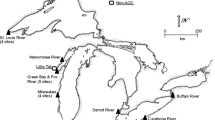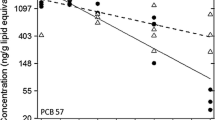Abstract
A large selection of polychlorinated biphenyl (PCB) congeners was determined in tissues from several British bird species including three sea birds, four birds of prey, and herons (Ardea cinerea). The congener “signatures” were consistent between different tissues of the same individual, but varied within and between species. Congeners 138, 153, and 180 were dominant in most samples. Nevertheless, ∑PCB values were wide ranging (0.02–105 μg/g wet weight) and also differed considerably in subsamples of different tissues from individual birds. Applying recently reported toxicity equivalency factors (TEFs) for non-ortho, mono-ortho, and di-ortho substituted PCBs to liver concentrations of such congeners, it appears that the mono-ortho congeners 105 and 118 make a high contribution to TEFs when their toxicities are weighted by concentration. The study highlights that caution is needed when interpreting data on contaminants in wildlife, but suggests that careful sampling will reduce the many variables which can give rise to differing congener patterns and ∑PCB values.
Similar content being viewed by others
References
Boon JP, Oudejans RCHM, Duinker JC (1984) Kinetics of individual PCB components in juvenile sole in relation to their concentrations in food and to lipid metabolism. Comp Biochem Physiol 79:131–142
Borlakoglu JT, Wilkins JPG, Walker CH, Dils RR (1990a) PCBs in fish-eating sea birds—I. Molecular features of PCB isomers and congeners in adipose tissue of male and female razorbills (Alca tarda) of British and Irish coastal waters. Comp Biochem Physiol 97C:151–160
—, —, —, — (1990b) PCBs in fish-eating sea birds—II. Molecular features of PCB isomers and congeners in adipose tissue of male and female puffins, guillemots, shags, and cormorants of British and Irish coastal waters. Comp Biochem Physiol 97C:161–171
Buhler DR, Williams DE (1988) The role of biotransformation in the toxicity of chemicals. Aquatic Toxicol 11:19–28
Cooke AS, Bell AA, Haas MB (1982) Predatory birds, pesticides and pollution. Institute of Terrestrial Ecology, Cambridge
Crivelli A, Focardi S, Fossi C, Leonzio C, Massi A, Renzoni A (1989) Trace elements and chlorinated hydrocarbons in the eggs of Pelecanus cristus, a world endangered bird species nesting at Lake Mikri Prespa, North Western Greece. Environ Pollut 61:235–248
Duarte-Davidson R, Burnett V, Waterhouse KS, Jones KC (1991) A congener specific method for the analysis of polychlorinated biphenyls (PCBs) in human adipose tissue and milk. Chemosphere 23:119–131
Elliot JE, Butler RW, Norstrom RJ, Whitehead PE (1989) Environmental contamination and reproductive success of great blue herons in British Columbia 1986–7. Environ Pollut 59:91–114
Focardi S, Leonzio C, Fossi C (1988) Variation in PCB congener composition in eggs of Mediterranean water-birds in relation to their position in the food chain. Environ Pollut 52:243–256
Harrad SJ, Boumphrey R, Duarte-Davidson R, Sewart A, Jones KC (1992) A method for the extraction and analysis of the non-ortho substituted polychlorinated biphenyls (PCBs) in biotic and abiotic matrices. Chemosphere 24:1147–1154
Heidmann WA, Staats de Yanes G, Buthe A, Russel-Sinn H (1992) Correlation between concentration and composition of PCB mixtures in seals (Phoca vitulina). Chemosphere 24:1111–1117
Jones KC (1988) Determination of PCBs in human foodstuffs and tissues suggestions for a selective congener analytical approach. Sci Tot Environ 68:141–159
Newton I, Bogan JA, Haas MB (1989) Organochlorines and mercury in the eggs of British peregrines (Falco peregrinus). Ibis 131:355–376
Newton I, Haas MB (1988) Pollutants in merlin eggs and their effects on breeding success. Brit Birds 81:258–269
Newton I, Haas MB, Freestone P (1990) Trends in organochlorine and mercury levels in Gannet eggs. Environ Pollut 63:1–12
Norstrom RJ (1988) Bioaccumulation of PCBs in Canadian wildlife. In: Crine JP (ed) Hazards, decontamination and replacement of PCBs. Plenum Publ Corp, NY
Norstrom RJ, Hallet DJ, Sonstegard RA (1978) Coho salmon and herring gulls as indicators of organochlorine contamination in Lake Ontario. J Fish Res Board Can 35:1401–1409
Ormerod SJ, Tyler SJ (1992) Patterns of contamination by organochlorines and mercury in the eggs of two river passerines in Britain and Ireland with reference to individual PCB congeners. Environ Pollut 76:233–243
Safe S (1990) PCBs, PCDDs, PCDFs and related compounds: Environmental and mechanistic considerations which support the development of toxic equivalency factors (TEFs). Crit Rev Toxicol 21:51–88
-- (1991) Platform presentation number S23 at “Dioxin 91,” Chapel Hill, NC, September 1991
Smith LM, Schwartz TR, Feltz K (1990) Determination and occurrence of Ahh-active PCBs, 2,3,7,8-TCDD and 2,3,7,8-TCDF in Lake Michigan sediment and biota. Chemosphere 21:1065–1085
Sung JK, Tanabe S, Choi DY, Tatsukawa R, Baba N, Kiyota M, Yoshida K (1991) Variations of organochlorine residue levels with age and time in northern fur seals from pacific coast of Japan since 1971. Platform presentation at Society of Environmental Toxicology and Chemistry, 12th annual meeting, Seattle, WA, November 1991
Turle R, Norstrom RJ, Collins B (1991) Comparison of PCB quantitation methods: re-analysis of archived specimens of herring gull eggs from the great lakes. Chemosphere 22:201–213
Walker CH (1983) Pesticides and birds: mechanisms of selective toxicity. Agric Ecosyst Environ 9:211–226
Author information
Authors and Affiliations
Rights and permissions
About this article
Cite this article
Boumphrey, R.S., Harrad, S.J., Jones, K.C. et al. Polychlorinated biphenyl congener patterns in tissues from a selection of British birds. Arch. Environ. Contam. Toxicol. 25, 346–352 (1993). https://doi.org/10.1007/BF00210726
Received:
Revised:
Issue Date:
DOI: https://doi.org/10.1007/BF00210726




